
Learning module on ways to adapt products to fit foreign markets.
- Subject:
- Economics
- Social Science
- Material Type:
- Lecture Notes
- Provider:
- TeachingWithData.org
- Provider Set:
- TeachingWithData.org
- Author:
- GlobalEDGEAcademy
- Date Added:
- 11/07/2014

Learning module on ways to adapt products to fit foreign markets.
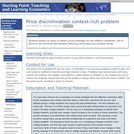
Students prepare an essay to explain pricing strategies for two different companies.

This interactive and collaborative activity asks students to first react to price changes and then analyze the results. Instructors can upload the materials to their own Google drives and run the experiment repeatedly to generate new data and demonstrate trends. This resource was developed by Birjees Ashraf, Sophie Haci, Renee Edwards, and Charles Hackner.
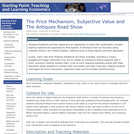
An interactive lecture segment utilizing videos from the Antiques Roadshow, designed to create an interactive experience for students and the instructor. After watching an expert appraisal of a rare/unique object students respond to discussion questions. Instructors lead the discussion toward issues of subjective value, willingness to pay, and the price mechanism.

Remember when airlines started charging for checked bags? What happened to the number of checked bags after this added charge? And what happened to the availability of in-cabin storage space on planes? The April 2013 issue answers these questions and discusses the pivotal role price plays in a market economy.

Learning module on pricing products for foreign sale.
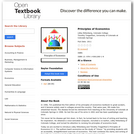
Flat World Knowledge is thrilled to publish a first edition re-launch of Tim Tregarthen’s acclaimed Principles of Economics book, and proud to bring Tim's remarkable talents as a teacher to future generations of students.In 1996, Tim published the first edition of his principles of economics textbook to great acclaim, and it became widely used in colleges around the country. That same year, MS made him wheelchair-bound. The disease forced his retirement from teaching at the University of Colorado at Colorado Springs in 1998. He lost the use of his arms in 2001 and has been quadriplegic ever since.Tim never let his disease get him down. In fact, he turned back to his love of writing and teaching for inspiration. He obtained a voice-activated computer, recruited a co-author, Libby Rittenberg of Colorado College, and turned his attention to revising his principles of economics book.Today we are excited to introduce Libby Rittenberg and Timothy Tregarthen’s Principles of Economics. The authors teach economics as the study of “choice “ by providing students with an accessible, straightforward overview of economics. This text combines the clarity and writing of Tregarthen's seminal periodical "The Margin" with great teaching insights.Rittenberg and Tregarthen help students to understand how real individuals actually work with economics. In this new book, the authors illustrate the practicality and relevance of economics with a variety of new illustrations and insights.The authors take a three-pronged approach to every concept: (1) the concept is covered with a “Heads Up” to ward off confusion, (2) a “You Try It” section makes sure students are staying on top of the concept and (3) a “Case and Point” section that uses a real-world application to harness the concept in reality. For one example of how this plays out in the text see "Chapter 3, Section 2 on Supply." hereThis book is intended for a two-semester course in economics taught out of the social sciences or business school.
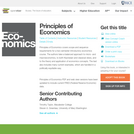
Principles of Economics covers scope and sequence requirements for a two-semester introductory economics course. The authors take a balanced approach to micro- and macroeconomics, to both Keynesian and classical views, and to the theory and application of economics concepts. The text also includes many current examples, which are handled in a politically equitable way.
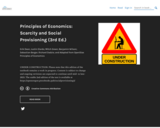
Short Description:
UNDER CONSTRUCTION. Please note that this edition of the textbook remains a work in progress. Content is subject to change and ongoing revisions are expected to continue until mid- to late-2023. The stable 2nd edition of the text is available at https://openoregon.pressbooks.pub/socialprovisioning2/
Word Count: 550396
(Note: This resource's metadata has been created automatically by reformatting and/or combining the information that the author initially provided as part of a bulk import process.)
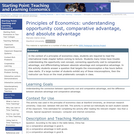
In principles of economics students many times have trouble understanding the concept of opportunity cost, connecting opportunity cost to comparative advantage, and differentiating between absolute advantage and comparative advantage. This activity allows the instructor to detect whether a large number of students exhibit any of these misconceptions, and then focus on the most problematic concepts in class.
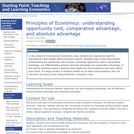
In principles of economics students many times have trouble understanding the concept of opportunity cost, connecting opportunity cost to comparative advantage, and differentiating between absolute advantage and comparative advantage. This activity allows the instructor to detect whether a large number of students exhibit any of these misconceptions, and then focus on the most problematic concepts in class.

Designed to meet the scope and sequence of your course, Principles of Finance provides a strong foundation in financial applications using an innovative use-case approach to explore their role in business decision-making. An array of financial calculator and downloadable Microsoft Excel data exercises also engage students in experiential learning throughout. With flexible integration of technical instruction and data, this title prepares students for current practice and continual evolution.
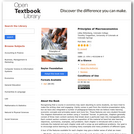
Recognizing that a course in economics may seem daunting to some students, we have tried to make the writing clear and engaging. Clarity comes in part from the intuitive presentation style, but we have also integrated a number of pedagogical features that we believe make learning economic concepts and principles easier and more fun. These features are very student-focused. The chapters themselves are written using a “modular” format. In particular, chapters generally consist of three main content sections that break down a particular topic into manageable parts. Each content section contains not only an exposition of the material at hand but also learning objectives, summaries, examples, and problems. Each chapter is introduced with a story to motivate the material and each chapter ends with a wrap-up and additional problems. Our goal is to encourage active learning by including many examples and many problems of different types.
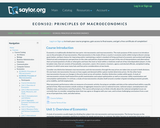
The purpose of this course is to provide the student with a fundamental understanding of the principles of macroeconomics. Macroeconomists study how a country's economy works and try to determine the best choices to improve the overall wellbeing of a nation. Typical topics include inflation (the overall level of prices), employment, fiscal policy (government taxing and spending), and money and banking (interest rates and lending policies). By studying macroeconomics and understanding the critical ideas and tools used to measure economic data, the student will have a better perspective on the issues and problems discussed in contemporary economics. Upon successful completion of this course, the student will be able to: Discuss key macroeconomic concerns, including national income accounting, saving and investment, and market forces; Describe the determinants of total output and the ways to measure nominal Gross Domestic Product (GDP) as well as real GDP; Compare and contrast definitions of total employment and unemployment, the three forms of unemployment, and inflation; Explain different ways of computing the general movement in prices, and define the relationship between inflation and unemployment; Explain the model of aggregate demand and aggregate supply; Analyze the government's role in the economy and examine how it uses its fiscal policy and monetary policy to influence macroeconomic variables in order to enable macro and micro economic stability; Describe the mechanics of money supply in detail. They will specifically be able to identify different types of money; explain the money creation process, the money multiplier, and the process of interest rate determination; and discuss the role of the Federal Reserve System and its tools of monetary policy; Identify and analyze major theories of economic growth; Analyze various strategies for developing of less-developed nations; Present the concepts behind international trade. (Economics 102; See also: Business Administration 201)

What is a recession? What happened to the U.S. economy in 2020 and 2021, and how did the pandemic, tax and spending policies, and monetary policies affect it? What happened in 2008–2009, during the “Global Financial Crisis”? Why is inflation higher today than at any time in the last three decades? Why does the unemployment rate vary over time? Why is there unemployment at all? Why do exchange rates between currencies fluctuate? How do policies in one country affect other countries? Why do economies grow at different rates? Why has China’s growth rate exceeded that of the U.S. for more than 30 years, and will such disparities continue? What explains movements in the stock market? These are some of the core questions of macroeconomics. If you are curious about the answers, then this is the course for you.
The course is organized around four major themes: the determinants of short-run economic fluctuations; the determinants of long-run growth; the investigation of government policies, including monetary policy, government spending, and exchange rate policy; and the analysis of key economic sectors, such as consumer spending, business investment, and financial markets.

This course provides an overview of the following macroeconomic issues: the determination of output, employment, unemployment, interest rates, and inflation. Monetary and fiscal policies are discussed, as are public debt and international economic issues. This course also introduces basic models of macroeconomics and illustrates principles with the experience of the United States and other economies.

Principles of Macroeconomics is an adaptation of the textbook, Macroeconomics: Theory, Markets, and Policy by D. Curtis and I. Irvine, and presents a complete and concise examination of introductory macroeconomics theory and policy suitable for a first introductory course.
Examples are domestic and international in their subject matter and are of the modern era — financial markets, monetary and fiscal policies aimed at inflation and debt control, globalization and the importance of trade flows in economic structure, and concerns about slow growth and the risk of deflation, are included.
This textbook is intended for a one-semester course, and can be used in a two-semester sequence with the companion textbook, Principles of Microeconomics. The three introductory chapters are common to both textbooks.

Principles of Macroeconomics 2e covers the scope and sequence of most introductory economics courses. The text includes many current examples, which are handled in a politically equitable way. The outcome is a balanced approach to the theory and application of economics concepts. The second edition has been thoroughly revised to increase clarity, update data and current event impacts, and incorporate the feedback from many reviewers and adopters.Changes made in Principles of Macroeconomics 2e are described in the preface and the transition guide to help instructors transition to the second edition.

